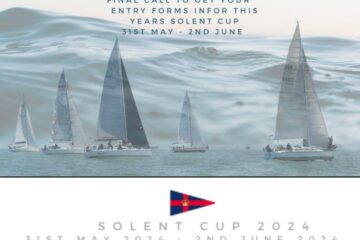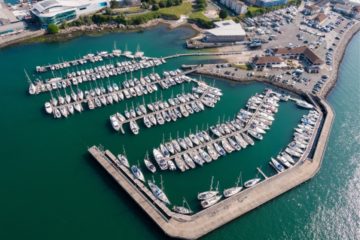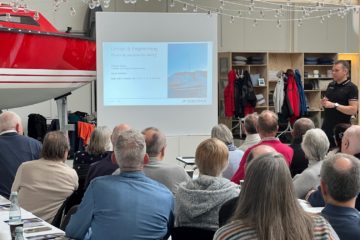Juno’s 2017 Rolex Fastnet …..
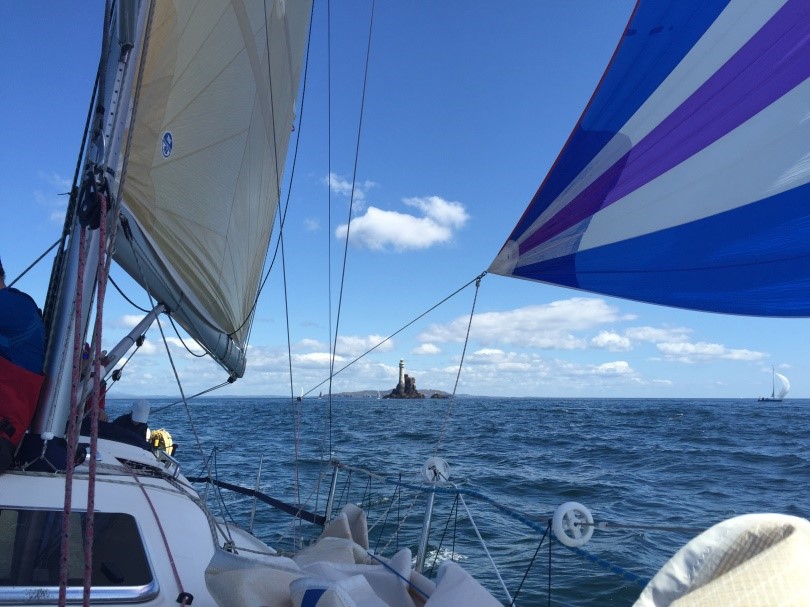
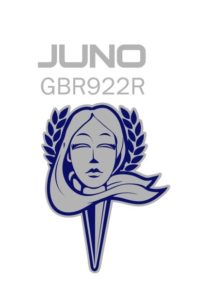 .......started back in October 2016 with a conversation with regular crew Mark who persuaded me to attempt to take Juno round the rock for a third time (and my 5th trip). Ironically Mark was then transferred to Singapore in early 2017, after I had entered Juno for the race, and was unable to join us. However, he has already booked for 2019.
.......started back in October 2016 with a conversation with regular crew Mark who persuaded me to attempt to take Juno round the rock for a third time (and my 5th trip). Ironically Mark was then transferred to Singapore in early 2017, after I had entered Juno for the race, and was unable to join us. However, he has already booked for 2019.
Entering/completing the Fastnet is really a project management process with a number of strands
- Crew recruitment
- Boat preparation
- Victualling
- Training/experience qualification
- Other logistics/admin
- The Fastnet itself
- Afterwards
The race itself - though the primary purpose - is really just the tip of a fairly large ice-berg.
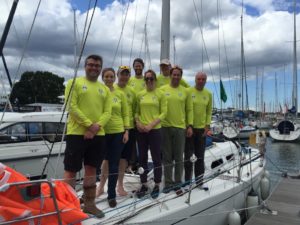 Crew Recruitment - By the end of 2016 I had 6 people (including myself) signed up, all of whom had sailed on Juno previously, including most importantly a dedicated navigator. Past experience had told me not to attempt to take on that role as well as being skipper and finding someone to replace our "retired" ex-naviguesser was a pre-condition for me.
Crew Recruitment - By the end of 2016 I had 6 people (including myself) signed up, all of whom had sailed on Juno previously, including most importantly a dedicated navigator. Past experience had told me not to attempt to take on that role as well as being skipper and finding someone to replace our "retired" ex-naviguesser was a pre-condition for me.
January saw our number reach the target of 8, allowing for two watches of 4 people, with the recruitment of two entirely new people. Six out of the 8 people on board had previously done a minimum of one Fastnet & in some cases considerably more.
Boat preparation - As an X-34 that has been raced regularly Juno needed little extra preparation, outside of routine maintenance over the winter. However we did finally fit the kit for a third reef pennant, thus avoiding the task of having to try and thread a line through the clew while actually putting in the reef. Along the way we had a joint on the luff foil fail, forcing us to retire from one of our planned qualifying races. As a result we replaced all the joints with a newer improved design.
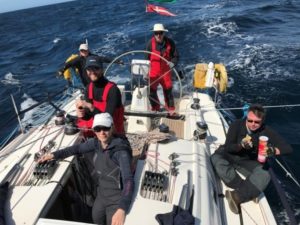 Victualling - In the past although this has been a collaborative effort, I have coordinated it all myself. Fortunately one of our new recruits expressed a keen interest in the subject so this time I was able to also delegate the coordination. On Juno I firmly believe in trying to have one hot meal a day and in the qualifying races we tried out a number of "Look What We Found" boil in the bag meals. For the Fastnet itself we combined a number of meals from this range with a couple of meals from pre-cooked and frozen home-made food.
Victualling - In the past although this has been a collaborative effort, I have coordinated it all myself. Fortunately one of our new recruits expressed a keen interest in the subject so this time I was able to also delegate the coordination. On Juno I firmly believe in trying to have one hot meal a day and in the qualifying races we tried out a number of "Look What We Found" boil in the bag meals. For the Fastnet itself we combined a number of meals from this range with a couple of meals from pre-cooked and frozen home-made food.
We also made use of supplements usually sold for consumption by cyclists to combat dehydration and to provide protein/carbohydrate boosts in the middle watches of the night.
Training/Experience qualification - As part of the general trend towards a more safety conscious environment (and prompted especially by the terrible events of 1979) it's not possible these days to just turn up on the start line without prior planned and checked training and experience. Certain percentages of the crew need to have:
- In-date World Sailing offshore safety training (5 year life)
- First aid qualifications (3 year life)
- Raced on the boat within 12 months preceding the Fastnet for at least 300 miles of RORC races
Crew have to upload their training certificates to the RORC race management system and the detailed proposal to complete the qualifying mileage needs to be pre-approved and subsequently confirmed as completed by the RORC race admin team.
Juno's planned qualifying races were:
- Cervantes Trophy: Cowes - Le Havre (appx 120 miles)
- De Guingand Bowl: Cowes - round marks - Solent (appx 120 miles)
- Myth of Malham: Cowes-Eddystone - Solent (appx 250 miles)
Unfortunately our luff foil developed problems early in the Myth so we had to retire which was particularly irritating because the race is a good rehearsal for the opening stages of the Fastnet itself. However, a hasty late entry into the forthcoming Morgan Cup to St Peter Port enabled us to complete our requisite mileage with a scheduled "weekend" to spare. For this final outing, 2 weeks before the Fastnet itself, we decided to focus on training inshore to practice boat handling skills. As one of the team said "We all know how to sit on the side deck for 4 hour". However, time spent gybing spinnakers is never wasted!
Other logistics - A couple of other items need to be considered before the start. Firstly, how much kit is allowed on board and how to reunite crew with the rest of their gear in Plymouth? On Juno we allow a 30l kit bag which must include everything (including sleeping bag) except what you are wearing. This essentially leaves room for a change of sailing clothes and an extra fleece or two. Anything else required in Plymouth has to go via the very efficient bag drop service that the RORC organise.
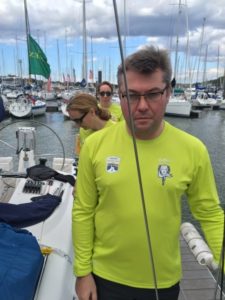 The other big issue is the crew souvenir! As most of the Juno crew have by now accumulated a large selection of jackets and polo shirts we decided on something highly practical - a base layer garment that could be worn many times.
The other big issue is the crew souvenir! As most of the Juno crew have by now accumulated a large selection of jackets and polo shirts we decided on something highly practical - a base layer garment that could be worn many times.
The executive committee decided on the colour. One Facebook wag commented that we looked like the crew off early Startrek episodes.
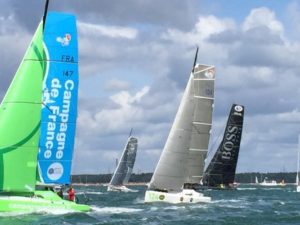 The Race - Our start was at 11.20 on 6 August, the first (and slowest) of the IRC classes to start after the professionals and Open 40s were sent on their very swift way. It's always an exciting time, milling around (briefly) in the company of some well-known names. Conditions this year were ideal with bright sunshine and a good breeze. There's nothing worse than setting off for 5 days or so in pouring rain or a gale.
The Race - Our start was at 11.20 on 6 August, the first (and slowest) of the IRC classes to start after the professionals and Open 40s were sent on their very swift way. It's always an exciting time, milling around (briefly) in the company of some well-known names. Conditions this year were ideal with bright sunshine and a good breeze. There's nothing worse than setting off for 5 days or so in pouring rain or a gale.
Since the course is known far in advance there can be little excuse for not having considered in some detail the first part of the race, having studied the weather patterns during the week leading up to the start. Critically for a boat of Juno's size is whether or not she will get past Portland Bill on the first tide. I have never succeeded yet! So we headed west initially till about St Albans Head where we turned south to be well offshore when the tide turned foul. So started what turned into a long upwind slog all the way to the Fastnet Rock!
Conditions this year were reasonably benign though. In the Celtic Sea on the way to Ireland we had some hail storms; some calms and a top wind speed of around 27-28 knots in the middle of the night inevitably, with noticeably bigger seas than would be found in more sheltered waters. Nonetheless two boats in other classes with which we had personal links both suffered rig problems and had to retire.
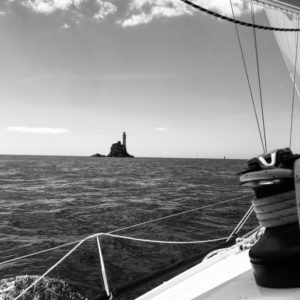 Winds initially on rounding Lands End were from the NE but expected to veer to more northerly in due course. So we stayed somewhat to the north of the rhumb line to take advantage of the shift if/when it came. Which for once it did: so our last 90 miles or so to the rock were on starboard tack with sheets just cracked. By Wednesday morning we had the Rock in sight amidst bright sunshine and calm seas. This was fortunate as it meant less of the champagne was spilled as we raised a glass in toast as we rounded!
Winds initially on rounding Lands End were from the NE but expected to veer to more northerly in due course. So we stayed somewhat to the north of the rhumb line to take advantage of the shift if/when it came. Which for once it did: so our last 90 miles or so to the rock were on starboard tack with sheets just cracked. By Wednesday morning we had the Rock in sight amidst bright sunshine and calm seas. This was fortunate as it meant less of the champagne was spilled as we raised a glass in toast as we rounded!
The benefit of having sailed upwind all the way to SW Ireland was that (for once) the wind played fair and held its broadly northerly direction for the next 24 hours, enabling us to have an increasingly swift downwind ride back to the Scillies.
We needed just one gybe between Fastnet and the Scillies TSS and set a new top speed for Juno of 15.3 knots during Wednesday night. Fun!
Arriving at the Scillies it is always tempting to think you are nearly finished. In fact there is around 100 miles still to go. By the time we got there the wind had eased and backed to NW/W as predicted with a further shift to the SW forecast. In fact the trip from there to Plymouth was fairly uneventful and relatively straightforward – just a question of trying to keep the boat going as quickly as possible.
The final leg in from the Lizard to the finish was its usual stressful self with the wind distinctly variable in strength and direction. We made it to Draystone PHM (about 1.5 nm from the finish line) under A3 then S4. As usual when a mile from the finish the wind then died and we had an ebb tide coming out of the harbour. Over the last mile we changed headsail 3 times, finally crossing the line at 03.21 on Friday morning - 4 days 16 hours and 1 minute after we started.
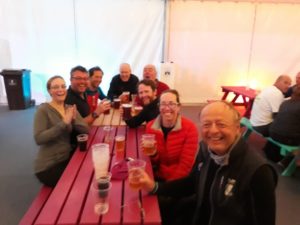
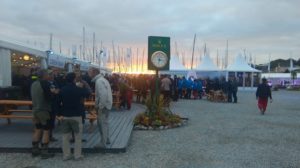 Of course there was then only one thought in our minds: where we stayed until the sun came up!
Of course there was then only one thought in our minds: where we stayed until the sun came up!
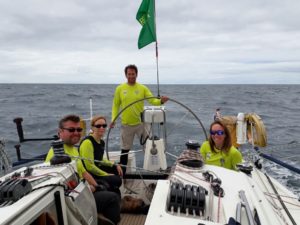 Afterwards - The rest of Friday was spent sleeping, clearing up the boat, checking our placing, and attending the prize-giving and our own end of race meal in the evening. Then after a most enjoyable Thai meal in our favourite Plymouth restaurant we said some goodbyes in the rain as 3 of the team had to leave early in the morning to meet their family commitments. The remaining 5 of us topped Juno up with water and diesel and slipped lines at about 11.30 on Saturday, bound for Hamble, enjoying a very relaxed sail home under spinnaker almost to the Needles and arriving at Port Hamble at about 10.00 on Sunday.
Afterwards - The rest of Friday was spent sleeping, clearing up the boat, checking our placing, and attending the prize-giving and our own end of race meal in the evening. Then after a most enjoyable Thai meal in our favourite Plymouth restaurant we said some goodbyes in the rain as 3 of the team had to leave early in the morning to meet their family commitments. The remaining 5 of us topped Juno up with water and diesel and slipped lines at about 11.30 on Saturday, bound for Hamble, enjoying a very relaxed sail home under spinnaker almost to the Needles and arriving at Port Hamble at about 10.00 on Sunday.
After a final tidy and clear out it was time to say farewells - always a time of mixed emotions for me as it is quite difficult to re-enter "normal" life after a period of such intense close knit activity with a group of people I regard as good friends. In some senses you never want it to end - but only in some senses!
While we didn't trouble the prize-giving ceremony Juno finished 27th out of 83 in Class 4 - a top third result which I think we all felt was a fair reflection of our efforts. What pleased me the most was when one of the team later commented to me that it was their favourite 600 mile race so far, with a great bunch of people in a very well sorted boat. As a skipper I think that's about the best thing you can hear.
